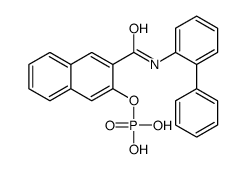N-(3-Hydroxytetradecanoyl)-DL-homoserine lactone

N-(3-Hydroxytetradecanoyl)-DL-homoserine lactone structure
|
Common Name | N-(3-Hydroxytetradecanoyl)-DL-homoserine lactone | ||
|---|---|---|---|---|
| CAS Number | 172670-99-4 | Molecular Weight | 327.45900 | |
| Density | 1.04±0.1 g/cm3(Predicted) | Boiling Point | 549.3±50.0 °C(Predicted) | |
| Molecular Formula | C18H33NO4 | Melting Point | N/A | |
| MSDS | Chinese USA | Flash Point | N/A | |
| Symbol |

GHS06 |
Signal Word | Danger | |
Use of N-(3-Hydroxytetradecanoyl)-DL-homoserine lactoneN-(3-Hydroxytetradecanoyl)-DL-homoserine lactone (N-(3-oxodecanoyl)-homoserine lactone) is a member of N-Acyl homoserine lactone (AHL) from V. alginolyticus strains. N-(3-Hydroxytetradecanoyl)-DL-homoserine lactone is used for biofilm formation and has antibacterial activity[1]. |
| Name | 3-Hydroxy-N-(tetrahydro-2-oxo-3-furanyl)tetradecanamide |
|---|---|
| Synonym | More Synonyms |
| Description | N-(3-Hydroxytetradecanoyl)-DL-homoserine lactone (N-(3-oxodecanoyl)-homoserine lactone) is a member of N-Acyl homoserine lactone (AHL) from V. alginolyticus strains. N-(3-Hydroxytetradecanoyl)-DL-homoserine lactone is used for biofilm formation and has antibacterial activity[1]. |
|---|---|
| Related Catalog | |
| In Vitro | Moderate levels of exogenous N-(3-Hydroxytetradecanoyl)-DL-homoserine lactone (N-(3-oxodecanoyl)-homoserine lactone; 10 and 20 μM) can induce or enhance biofilm formation and alter its structure, while high levels (40 and 100 μM) does not significantly improve and even inhibits biofilm formation in V. alginolyticus[1]. N-(3-Hydroxytetradecanoyl)-DL-homoserine lactone (2, 5, 10, 20 μM; 36 hours) increases the biofilms of strain N°24 significantly[1]. Moderate addition of N-(3-Hydroxytetradecanoyl)-DL-homoserine lactone (10 or 20 μM) also increases biofilm formation of non-AHL-producing peanut-nodulating bacteria[1]. |
| References |
| Density | 1.04±0.1 g/cm3(Predicted) |
|---|---|
| Boiling Point | 549.3±50.0 °C(Predicted) |
| Molecular Formula | C18H33NO4 |
| Molecular Weight | 327.45900 |
| Exact Mass | 327.24100 |
| PSA | 79.12000 |
| LogP | 3.93030 |
| InChIKey | IKQUESGRCDRZTI-UHFFFAOYSA-N |
| SMILES | CCCCCCCCCCCC(O)CC(=O)NC1CCOC1=O |
| Symbol |

GHS06 |
|---|---|
| Signal Word | Danger |
| Hazard Statements | H301 |
| Precautionary Statements | P301 + P310 |
| Hazard Codes | T+ |
| RIDADR | UN 2811 6.1 / PGIII |
|
Quorum sensing and biofilm formation by Streptococcus mutans.
Adv. Exp. Med. Biol. 631 , 178-88, (2008) Streptococcus mutans is the primary causative agent involved in dental caries in humans. Among important virulence factors of this pathogen, its ability to form and sustain a polysaccharide-encased bi... |
|
|
Quorum sensing in bacteria.
Annu. Rev. Microbiol. 55 , 165-99, (2001) Quorum sensing is the regulation of gene expression in response to fluctuations in cell-population density. Quorum sensing bacteria produce and release chemical signal molecules called autoinducers th... |
|
|
Regulation of gene expression by cell-to-cell communication: acyl-homoserine lactone quorum sensing.
Annu. Rev. Genet. 35 , 439-68, (2001) Quorum sensing is an example of community behavior prevalent among diverse bacterial species. The term "quorum sensing" describes the ability of a microorganism to perceive and respond to microbial po... |
| N-(3-Hydroxytetradecanoyl)-DL-homoserine lactone |
| 3-hydroxy-N-(2-oxooxolan-3-yl)tetradecanamide |